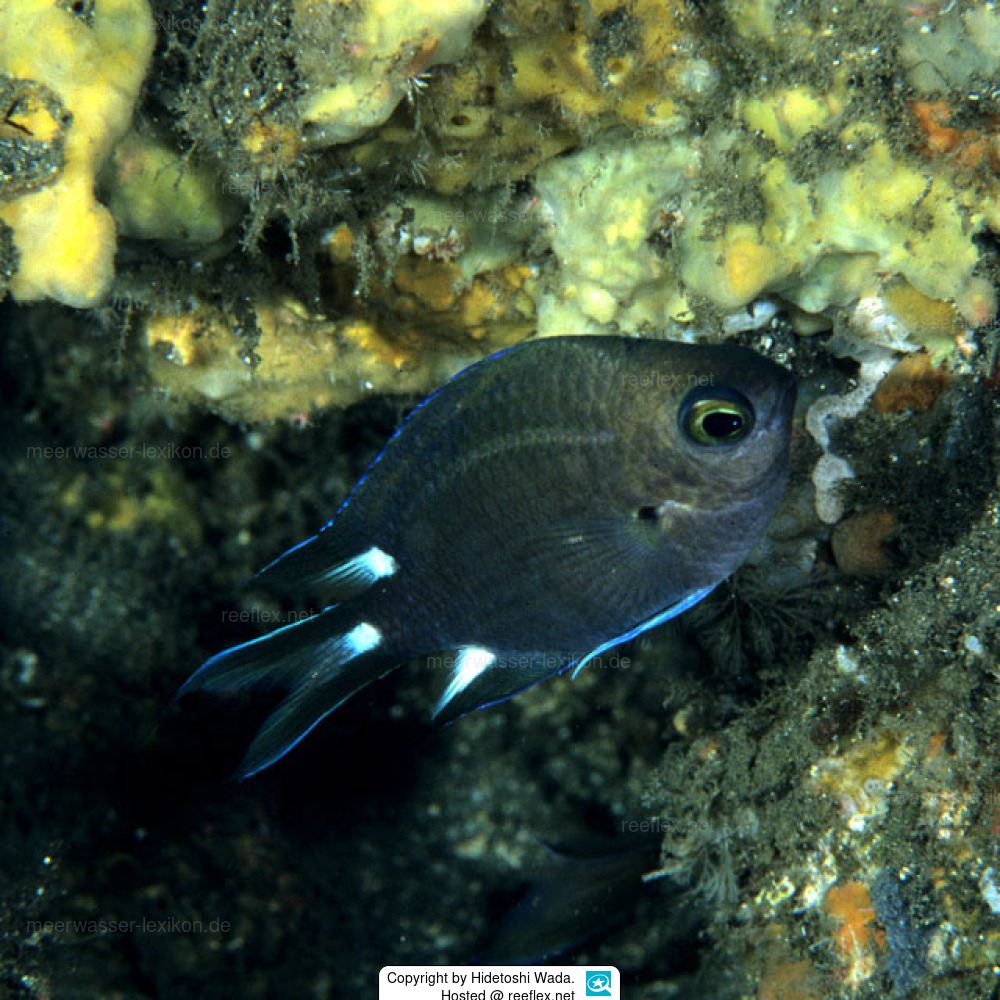Info
Chromis onumai is a resident of sloping walls of deeper reefs and is therefore rarely observed by divers.
Basic color in animals over 10cm in length:
Damsels of this size are light to reddish brown, the iris is reddish brown, sometimes yellowish brown.
The spiny dorsal fin is light yellow-brown with the exception of the reddish-brown scales on each fin membrane; the soft part of the dorsal fin in the front half is dark reddish-brown and the rear half is whitish and translucent with a faint, bluish-white spot the size of a pupil at the base of the rear rays.
The caudal fin is whitish and translucent with a prominent and broad dark brown stripe in each lobe and a faint, bluish-white spot the size of a pupil in the center of the base, while the anal fin in the front three quarters light yellowish to reddish brown and in the rear quarter whitish and translucent with a faint, bluish-white spot the size of a pupil at the base of the rear rays.
The pectoral fins are transparent, the upper corner of the base and the axis are black, the ventral fins are light yellowish to reddish brown, the front edge is whitish.
Coloring of a small fish:
In this size, the basic color of the small perch is a dull yellow, grayish red or grayish green; all fin edges are bluish.
Each spot on the dorsal, caudal and anal fins is clearly pronounced and has a radial marking at the rear end.
It is not sold by specialist retailers, but it is kept in aquariums in the countries of origin.
Etymology:
The species name “onumai” was given in honor of Hisashi Onuma, who first discovered the species.
We would like to express our sincere thanks to Dr. Hidetoshi Wada, curator of the zoology group (ichthyology department), Prefectural Museum of Natural History Kanagawa, 499 Iryuda, Odawara, Kanagawa 250-0031, Japan, for the first photo of a live perch.
Basic color in animals over 10cm in length:
Damsels of this size are light to reddish brown, the iris is reddish brown, sometimes yellowish brown.
The spiny dorsal fin is light yellow-brown with the exception of the reddish-brown scales on each fin membrane; the soft part of the dorsal fin in the front half is dark reddish-brown and the rear half is whitish and translucent with a faint, bluish-white spot the size of a pupil at the base of the rear rays.
The caudal fin is whitish and translucent with a prominent and broad dark brown stripe in each lobe and a faint, bluish-white spot the size of a pupil in the center of the base, while the anal fin in the front three quarters light yellowish to reddish brown and in the rear quarter whitish and translucent with a faint, bluish-white spot the size of a pupil at the base of the rear rays.
The pectoral fins are transparent, the upper corner of the base and the axis are black, the ventral fins are light yellowish to reddish brown, the front edge is whitish.
Coloring of a small fish:
In this size, the basic color of the small perch is a dull yellow, grayish red or grayish green; all fin edges are bluish.
Each spot on the dorsal, caudal and anal fins is clearly pronounced and has a radial marking at the rear end.
It is not sold by specialist retailers, but it is kept in aquariums in the countries of origin.
Etymology:
The species name “onumai” was given in honor of Hisashi Onuma, who first discovered the species.
We would like to express our sincere thanks to Dr. Hidetoshi Wada, curator of the zoology group (ichthyology department), Prefectural Museum of Natural History Kanagawa, 499 Iryuda, Odawara, Kanagawa 250-0031, Japan, for the first photo of a live perch.







 Dr. Hidetoshi Wada, Japan
Dr. Hidetoshi Wada, Japan










































































